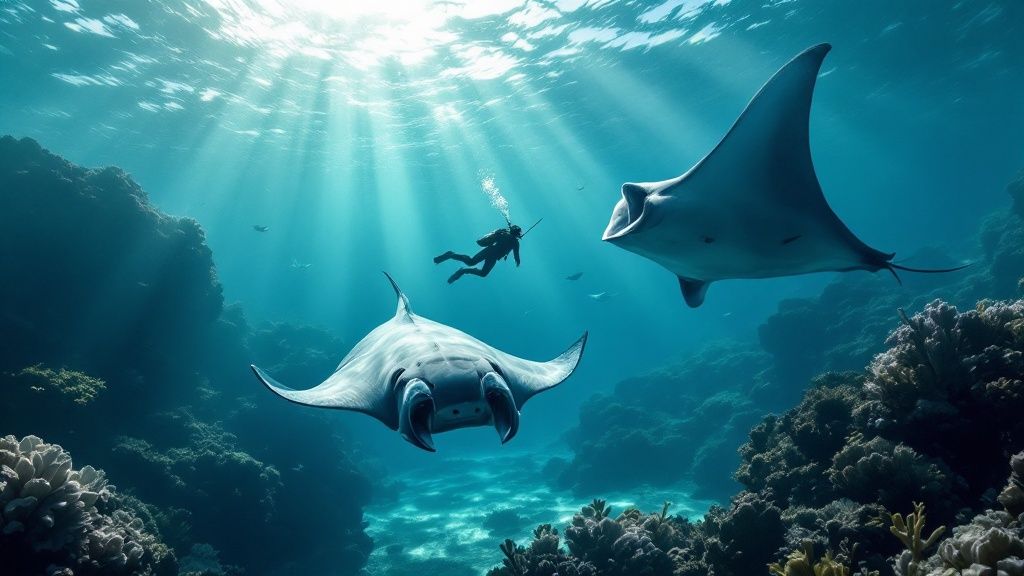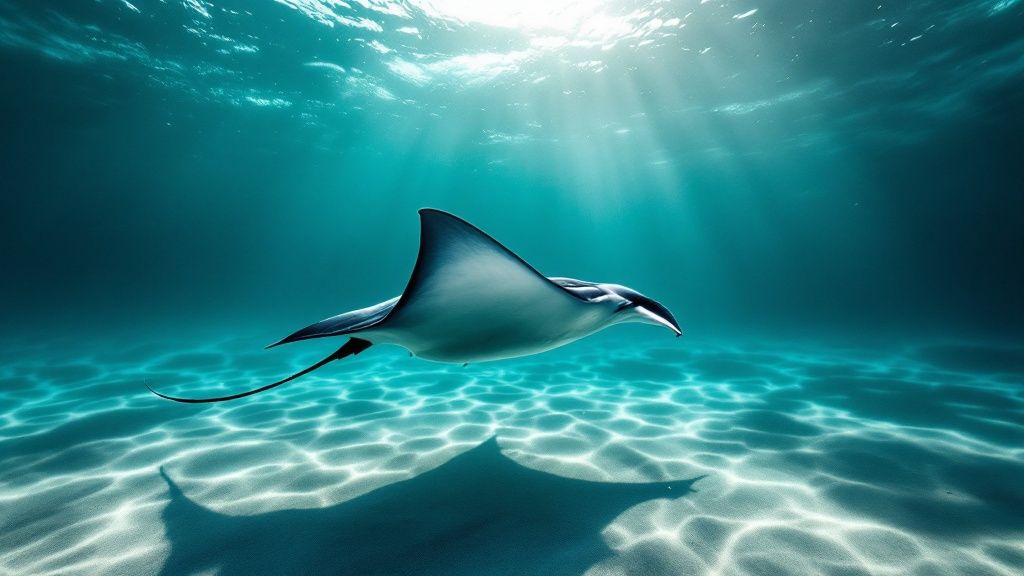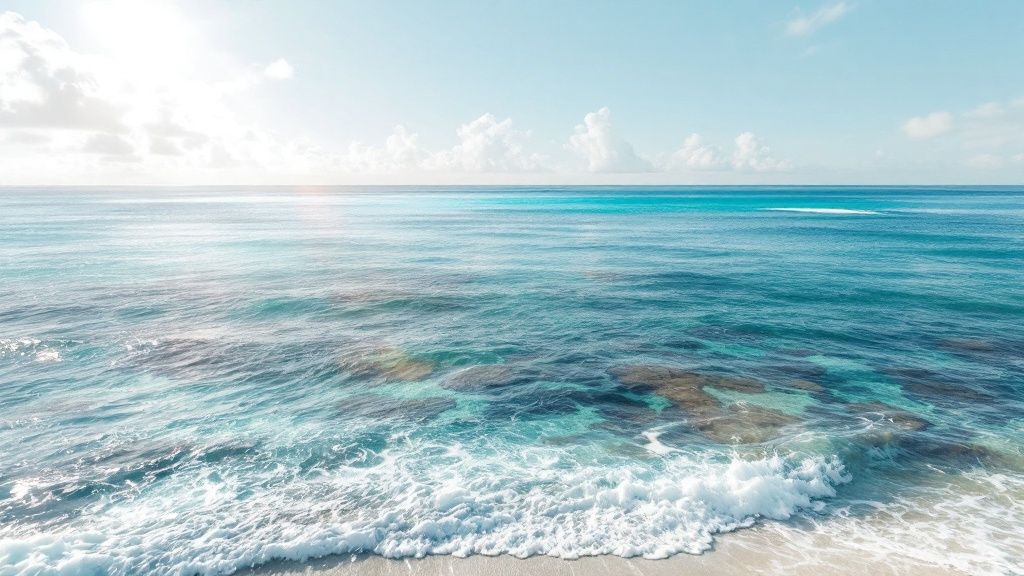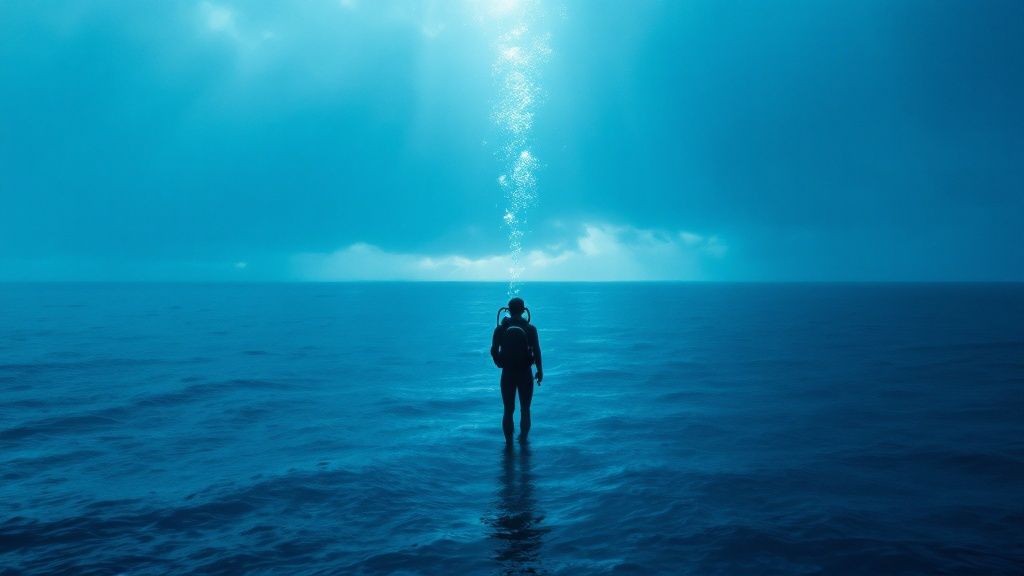Manta Snorkel Kona: Unforgettable Night Encounters
- Byron
- Mar 21
- 11 min read
Why Manta Snorkel Kona Delivers Magic Every Time

The Kona Coast isn't just another pretty Hawaiian destination; it's a hotspot for manta ray encounters. This unique area combines several factors that practically guarantee an unforgettable experience with these gentle giants. A manta snorkel Kona trip is truly unlike any other. But what makes this location so special?
One key factor is Kona's volcanic underwater topography. The sloping terrain creates perfect conditions for upwelling, bringing nutrient-rich water to the surface. This feeds a thriving plankton population, the manta rays' primary food source. It’s like a constant buffet being delivered right to them! This consistent food supply explains why mantas reliably grace the Kona Coast with their presence.
Kona also enjoys remarkably calm ocean conditions. These predictable waters make for comfortable and safe snorkeling, day or night. This is especially beneficial for night snorkeling, where calm waters enhance visibility and make navigating easier. Fewer cancellations due to rough seas mean more chances to experience this underwater magic.
Consistent Manta Ray Sightings
Manta ray sightings off the Kona Coast are remarkably consistent, with incredibly high success rates. Jack’s Diving Locker, for example, reports seeing manta rays on 85-90% of their night dives and snorkeling trips. This consistency stems from the unique Kona Coast conditions, including the calm waters and plentiful zooplankton that attract these magnificent creatures. Find more detailed statistics here. These impressive success rates solidify Kona's reputation as a top manta ray viewing destination.
Understanding Kona's Manta Ray Magnetism
Beyond the ideal environmental conditions, responsible viewing practices play a crucial role. Kona has pioneered sustainable manta ray tourism. Operators prioritize minimizing disturbances to the mantas and their habitat, ensuring a positive experience for both the animals and snorkelers. This careful approach helps preserve the mantas' natural feeding patterns, further enhancing the viewing experience.
The clear, warm Kona waters also provide exceptional visibility. Snorkelers get unbelievably close to the manta rays, observing their intricate markings and graceful ballet with breathtaking clarity. This up-close perspective transforms a simple snorkel trip into a truly immersive wildlife encounter. You might be interested in: Our other blog posts about manta rays.
Finally, all these elements create a perfect storm of manta magic. The abundant food source, calm waters, sustainable tourism practices, and excellent visibility combine to create a one-of-a-kind experience. It’s this consistent delivery of amazing manta ray encounters that sets Kona apart from other viewing locations worldwide.
Face-to-Face With Kona's Gentle Ocean Giants

A manta ray snorkel adventure off the Kona Coast is more than just a beautiful sight. It's a chance to connect with these gentle giants on a deeper level, learning about their fascinating world. From their captivating feeding habits to their unique markings, there's so much to discover, turning a simple snorkel into a truly profound wildlife experience.
Decoding the Manta Ballet
During a manta night snorkel, you'll be treated to a captivating show. As the mantas engage in their feeding rituals, they glide through the water, mouths open wide, filtering plankton illuminated by the tour boat's lights. This feeding behavior, often referred to as a mesmerizing "ballet," reveals the mantas' incredible agility and efficiency in capturing their tiny prey.
Identifying Individual Mantas
Like human fingerprints, each manta ray has a unique pattern of spots on its underside. These belly markings allow researchers and experienced guides to identify individual mantas. You can even learn to recognize some of these distinctive patterns yourself, making your encounter even more personal.
The Kona Coast is home to two main species of manta rays: the reef manta ray (Mobula alfredi) and the giant manta ray (Mobula birostris). Drawn to the underwater lights attracting their food source, zooplankton, these species are often seen during night dives and snorkeling trips. These lights create a veritable feast, providing exceptional observation opportunities. Learn more about manta rays in Hawai'i here. You can also check out our website pages for more tour details.
Intelligence and Social Interactions
Manta rays are incredibly intelligent. They've been seen displaying complex social behaviors, even recognizing regular tour boats. This intelligence shows in their feeding strategies, their interactions with one another, and their apparent curiosity toward snorkelers.
Distinguishing Reef and Giant Mantas
While both species are impressive, reef mantas are the more frequent visitors during Kona manta snorkels. Occasionally, however, the much larger giant manta, with its impressive potential 23-foot wingspan, makes a memorable appearance. Knowing the difference between the two enhances the whole experience.
By understanding the biology, behavior, and individual characteristics of these magnificent animals, your manta snorkel Kona adventure transforms from a simple activity into an educational and enriching encounter. It's a chance to foster a deeper appreciation for these gentle giants of the ocean.
Finding Your Perfect Manta Snorkel Kona Spot

Not all manta ray viewing locations are the same. Choosing the right spot for your Kona manta ray snorkel adventure significantly impacts your overall experience. Understanding the nuances of each location is key to enjoying intimate encounters, reliable sightings, and ideal photographic conditions. This section explores the distinct advantages of Kona's iconic manta ray spots, helping you find the perfect fit for your snorkeling style.
Manta Village vs. Manta Heaven: Two Distinct Experiences
Two of the most popular locations, Manta Village and Manta Heaven, offer very different experiences. Manta Village, nestled in Keauhou Bay, is known for its calmer waters and often provides more intimate encounters. This makes it a great choice for first-time snorkelers or those seeking a more relaxed experience. Manta Heaven, situated closer to the airport, is generally considered a more reliable spot for sightings, potentially offering a higher chance of seeing multiple mantas. However, the water conditions here can sometimes be a bit choppier.
The best choice depends on your priorities. Do you prefer calmer waters and the possibility of a close encounter, or is a guaranteed sighting, even in potentially choppier waters, more important to you?
Factors to Consider When Choosing a Spot
Beyond the two primary locations, other factors influence your experience. Consider the following:
Photography: Some locations offer better lighting and manta ray behavior for photography. Shallower depths and clearer water, for instance, can dramatically improve your photos.
Crowds: Popular spots can get crowded, especially during peak seasons. Choosing less popular locations or specific tour times can result in a more intimate and enjoyable experience.
Experience Level: Certain locations are better suited for beginners, while others cater to more experienced snorkelers comfortable in slightly more challenging conditions.
To help you make the best decision, we've compiled a comparison of the top manta ray viewing locations in Kona:
Top Manta Ray Viewing Locations in Kona: Comparison of the primary manta ray snorkeling locations along the Kona Coast, highlighting key features and success rates for sightings.
Location | Success Rate | Best Time | Accessibility | Average Mantas | Water Conditions |
|---|---|---|---|---|---|
Manta Village (Keauhou Bay) | High | Sunset-Night | Easy | 5-10 | Typically Calm |
Manta Heaven (Near Airport) | Very High | Sunset-Night | Easy | 10-20 | Can be Choppy |
Garden Eel Cove | Moderate | Sunset-Night | Moderate | 3-5 | Variable |
Kohanaiki (Private Access) | High | Sunset-Night | Difficult (Private) | 5-10 | Typically Calm |
This table summarizes the key features of each location, enabling you to compare their success rates, accessibility, and typical water conditions. Remember to consider your own priorities and experience level when selecting a spot.
The Allure of Manta Ray Gathering Spots
The reasons why mantas congregate at these specific locations are fascinating. Plankton, attracted by the lights of tour boats, is a major draw. The unique underwater topography of each location, such as volcanic slopes or reefs, influences currents and water flow, creating ideal feeding grounds for the mantas. These natural factors, combined with responsible tour practices, make Kona an exceptional destination for manta ray encounters.
Detailed statistics on manta ray sightings, particularly between 2009 and 2014, provide valuable insights. Researchers and divers meticulously documented individual manta rays observed during night dives at sites like Manta Village and Manta Heaven. This data helps us understand manta ray movement and behavior. Reports from 2013, for example, tracked the number of individual mantas sighted each month, providing information about habitat use and population dynamics. Find more detailed statistics here. You might be interested in our blog categories sitemap for further reading.
Crafting Your Perfect Manta Snorkel Kona Experience

Turning your manta ray dreams into a reality begins with thoughtful planning. A Kona manta ray snorkel adventure is more than just booking a tour; it's about understanding the nuances of each tour operator, the best time of year to go, and practical tips for maximizing your enjoyment. This guide will provide you with the insider knowledge you need to create a truly unforgettable experience.
Timing Your Manta Magic: Optimal Months For Snorkeling
Manta rays grace the Kona Coast all year round, but certain months offer a better balance of manta ray activity and calm ocean conditions. The dry season (April to October) typically offers calmer waters and increased visibility, perfect for snorkeling. The summer months (June-August) generally have the best visibility. However, this is also the busiest time of year, so booking your tour well in advance is essential. For a happy medium between pleasant weather and fewer crowds, the shoulder seasons (April-May & September-October) are a great choice.
Choosing Your Tour Operator: Beyond the Price Tag
Choosing the right tour operator is crucial to a successful manta ray snorkel experience. Factors beyond price, such as group size, guide experience, and eco-conscious practices, should significantly influence your decision. Smaller groups provide more personalized attention and minimize disruption to the mantas. Seek out operators with certified guides who have a deep understanding of manta ray behavior and prioritize sustainable tourism. These operators recognize the importance of respecting the mantas’ natural habitat and adhere to responsible viewing practices.
Addressing Common Concerns: Seasickness, Anxiety, and Photography
A little preparation can significantly enhance your experience. If you are prone to seasickness, consider taking precautions such as motion sickness medication or ginger supplements before embarking on the boat trip. Addressing any night swimming anxiety is also important. Talk to your tour guides about any concerns and consider using a life vest for added comfort and security. For those wanting to capture the magic with underwater cameras, a GoPro or similar device with a secure float strap is recommended. Remember to avoid using flash photography, as it can disorient and disturb the mantas.
Family-Friendly Options and Choosing Your Location
Traveling with children? Many operators offer family-friendly tours with experienced guides trained to work with younger snorkelers. Choosing your accommodation strategically can also reduce travel time. Staying in a hotel or rental near the boat launch point streamlines logistics and allows more time for your manta ray encounter. Consider locations in Keauhou Bay for easy access to Manta Village, or areas closer to the airport for convenient access to Manta Heaven.
Booking Smart: Tips For A Personalized Experience
A few lesser-known booking tips can greatly enhance your trip. Booking directly with tour operators, rather than through third-party platforms, often allows for greater flexibility and potential discounts. Inquire about private charters or smaller group options for a more intimate and personalized experience. Booking your manta snorkel early in your trip provides flexibility for rescheduling if weather conditions necessitate a change of plans. Many operators offer a "manta guarantee," allowing you to re-book for free if no mantas are sighted on your initial tour.
To help you select the perfect tour, we've compiled a comparison of several operators:
Manta Snorkel Tour Operator Comparison: Overview of reputable manta ray snorkel tour operators in Kona with key details to help you choose the right provider
Tour Operator | Group Size | Price Range | Equipment Provided | Boat Type | Duration | Extra Features |
|---|---|---|---|---|---|---|
Kona Honu Divers | 6-8 | $150-$180 | Mask, Snorkel, Fins, Wetsuit, Floatation Device | Inflatable Raft | 1.5-2 hours | Hot Beverages, Snacks |
Big Island Divers | 10-12 | $130-$160 | Mask, Snorkel, Fins | Catamaran | 2-2.5 hours | Underwater Photography Package |
Manta Ray Dives of Hawaii | 12-15 | $110-$140 | Mask, Snorkel, Fins, Wetsuit | Speedboat | 1-1.5 hours | Manta Guarantee |
This table offers a general comparison and serves as an example. Actual tour operator details and offerings may vary. Always visit individual operator websites for the most up-to-date information.
By understanding these key elements, you can craft a manta snorkel Kona adventure that’s not only unforgettable but also perfectly tailored to your individual needs and preferences.
Essential Safety Protocols for Manta Snorkel Kona
A manta snorkel Kona adventure is an exciting experience. However, safety for both snorkelers and the manta rays is key. Understanding the challenges of night snorkeling and choosing a responsible tour operator are vital for a memorable and safe trip.
Navigating the Night: Understanding the Challenges
Night snorkeling has unique safety considerations. Reduced visibility and navigating dark waters require careful preparation. Potential interactions with marine life also need attention. Responsible manta snorkel Kona operators address these challenges with thorough safety briefings, experienced guides, and the right equipment.
These operators use powerful underwater lights. These lights attract plankton, which the manta rays feed on. They also illuminate the snorkeling area, improving visibility for everyone. Additionally, flotation devices like pool noodles help snorkelers maintain a comfortable position in the water. This reduces fatigue and minimizes accidental contact with the manta rays.
Recognizing a Responsible Manta Snorkel Kona Operator
Choosing the right operator is crucial for a safe and enjoyable experience. Look for operators who prioritize small group sizes. This allows for personalized attention and reduces crowding. Guides should be experienced and certified in first aid and CPR. They provide clear instructions, monitor safety, and manage any unexpected situations.
Essential safety equipment, such as flotation devices and wetsuits, should be readily available and in good condition. Manta ray viewing operations in Kona have been assessed for safety, highlighting the risks of many vessels and participants in the water. On busy nights, up to 28 boats and hundreds of snorkelers and divers can be present. This significantly increases the risk of accidents. Explore this topic further.
Staying Safe and Comfortable in the Water
Comfort during your manta snorkel is essential. A wetsuit helps maintain body temperature in cooler night waters. Properly fitted masks and snorkels are vital for clear vision and easy breathing. Using a flotation device minimizes exertion, letting you relax and observe the manta rays.
Remaining calm and following the guide's instructions are also important for safety. You might be interested in: Our sitemap for other useful articles.
Responsible Interactions: Protecting Mantas and Yourself
Remember, you're a visitor in the manta rays' natural habitat. Avoid touching the manta rays. This can disrupt their protective mucous layer, making them vulnerable to diseases. Keep a respectful distance and let them approach you. Avoid sudden movements or loud noises that could startle them.
By following these guidelines, you contribute to a sustainable environment. This allows both snorkelers and manta rays to coexist safely. This approach improves the viewing experience and ensures the long-term health of these creatures.
Beyond Tourism: Your Role in Manta Snorkel Kona Conservation
Your manta ray snorkel Kona adventure offers more than just a personal thrill; it's a chance to actively participate in the conservation of these gentle giants. Sustainable tourism plays a crucial role in protecting these vulnerable creatures, and your choices directly impact their future.
How Sustainable Tourism Funds Conservation
Sustainable manta snorkel Kona tourism directly supports manta ray conservation efforts. Responsible tour operators often dedicate a portion of their profits to research and conservation initiatives. This funding fuels vital studies on manta ray populations, behaviors, and the threats they face. Some operators even partner with local organizations to conduct population surveys, track individual manta rays, and monitor reef health. By choosing a responsible operator like Manta Ray Night Snorkel, you directly contribute to these essential efforts.
Citizen Science: Your Photos Make a Difference
Your photos can play a surprisingly significant role in manta ray research. Organizations often maintain identification databases of individual manta rays based on their unique belly markings. Submitting your photos provides valuable data that researchers use to track manta ray movements, estimate population size, and monitor individual health over time. This information is crucial for scientists understanding the long-term impacts of environmental changes and human activities on manta ray populations.
The Economic Impact of Manta Ray Tourism
Manta ray tourism brings substantial economic benefits to local communities, creating jobs for guides, boat operators, and support staff. This economic impact incentivizes local communities to protect manta rays and their habitat. The success of manta ray tourism relies on healthy manta populations, further reinforcing the importance of sustainable practices. For more on our commitment to conservation, visit our sitemap.
Simple Actions With a Big Impact
Here are a few ways you can support manta ray conservation before, during, and after your trip:
Choose eco-conscious operators: Look for operators committed to sustainable practices like small group sizes, responsible viewing guidelines, and minimal environmental impact.
Respect the mantas: Adhere to guidelines for interacting with manta rays. Never touch them, maintain a safe distance, and avoid sudden movements or loud noises.
Participate in citizen science projects: Submit your photos to manta ray identification databases and consider donating to local conservation organizations.
Reduce your environmental footprint: Use reef-safe sunscreen, minimize waste, and avoid single-use plastics.
Protecting Manta Rays for Future Generations
By understanding your role in conservation and taking these simple steps, you contribute to ensuring these magnificent creatures thrive for generations to come. Your manta snorkel Kona experience becomes more than just a memory; it becomes a contribution to a vital conservation effort. Experience the magic and book your Manta Ray Night Snorkel Kona Hawaii Tour today!
Comments